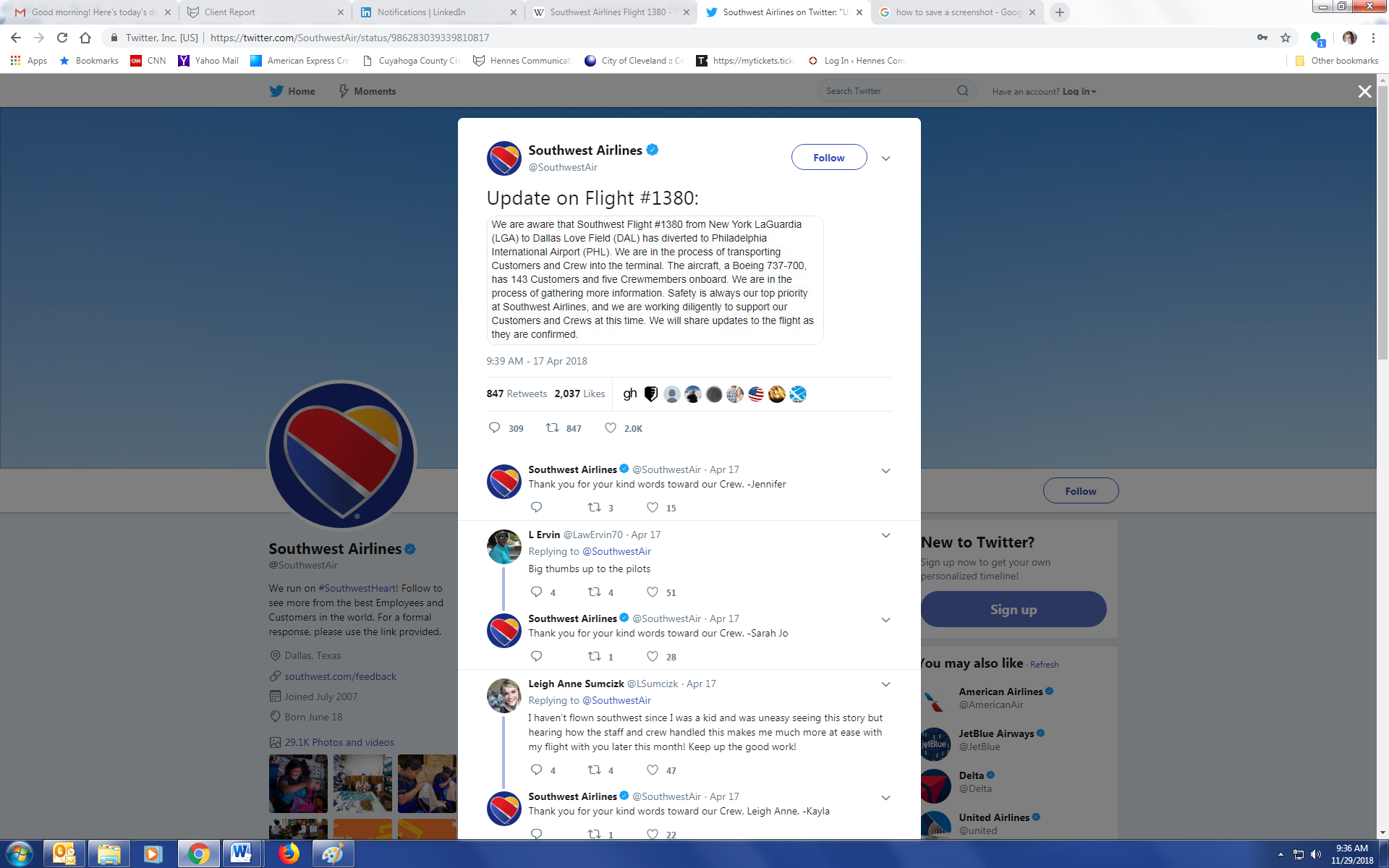


2018’s Best Crisis Management Response: The Crisis Was Live, Southwest Airlines Was Ready
By Thom Fladung/Hennes Communications
We’re hard-wired to hope bad news goes away. And when that hope is dashed, as it so often is, we hope that the fewest number of people possible find out about our bad news.
So, imagine your bad news being broadcast live to potentially millions of people.
That’s what Southwest Airlines experienced in 2018. As we enter the time of year for the inevitable “best of” lists, this one gets our vote for most effective crisis communications of 2018. And it provides one of the strongest examples imaginable of why planning for crises is essential.
On April 17, 2018, on Southwest Airlines Flight 1380 at 30,000 feet on the way from New York to Dallas, an engine ruptured. Shrapnel broke a window and passenger Jennifer Riordan was sucked headfirst into that opening. She would not survive.
Almost immediately, the crisis went public.
As the New York Times reported: “…passengers were scrambling to put on oxygen masks and buy internet access so they could send a last message to their children and families. Marty Martinez, 29, of Dallas, held a yellow oxygen mask to his face as he live-streamed the descent on Facebook. ‘It appears we are going down!’” he wrote.
The idea that everyone is a reporter, armed with a video camera in a cell phone, doesn’t qualify as news. But the situation on Southwest 1380 took that concept to a more dramatic level. The Wall Street Journal wrote: “Cellphone video has made aviation accidents and incidents more terrifying and troubling for the flying public. In the case of Southwest 1380, when an engine ruptured on a New York-to-Dallas trip and shrapnel broke a window, blowing the 43-year-old Ms. Riordan partly out of the airplane, we see the fear the passengers were experiencing like never before.”
And Southwest Airlines was facing the mother of airline crises.
Most importantly, of course, the plane was landed in Philadelphia by Southwest pilot Tammie Jo Shults, a Navy veteran who’d flown F/A-18 Hornets as one of the Navy’s first female pilots and whose cool demeanor and skill made her an immediate hero.
Still, with the plane on the ground, Southwest had to deal with the first death of a passenger on a U.S. flight since 2009 and the first death on a Southwest flight in its 51-year history – amid the continuing torrent of photos, videos, tweets and texts from passengers on that flight going viral.
The airline used those passengers’ accounts, which might have frozen a less prepared organization, to its advantage. “The photos, video and tweets also kept the airline better-informed about what was happening, and heightened the need for the airline to quickly respond,” the Wall Street Journal reported. “Like most airlines, Southwest has a social-media listening team that fed real-time information to executives as the accident developed. … Laurie Barnett, Southwest’s managing director of communications and outreach and one of the authors of the response plan, says that information aided the response.”
Southwest kicked its crisis response into high gear.
- CEO Gary Kelly quickly issued a statement that put the emphasis on empahy: “It is with great sadness that I confirm there was a passenger fatality on Flight 1380. This a sad day, and on behalf of the entire Southwest family, I want to extend my deepest sympathies for the family, and the loved ones of our deceased customer. They are our immediate and primary concern, and we will do all that we can to support them during this difficult time and the difficult days ahead.”
- The airline’s website banner and Twitter profile image changed from the signature red, yellow and blue heart symbol to a gray, broken heart.
- The normal marketing of deals and promotional messages via Twitter, emails and commercials stopped.
- All Flight 1308 passengers were given $5,000, a credit of $1,000 toward Southwest airfare and transportation to their destination out of Philadelphia.
To be sure, there was a heavy price to pay. As the Dallas Business Journal reported, Southwest said in its second quarter earnings report that the accident had a $100 million impact on revenue, largely from the decision to cool those marketing and advertising efforts for about a month in the wake of the tragedy.
And as Fortune reported, eight of the passengers filed a lawsuit against the airline.
But by early June, in a poll of 2,000 American adults conducted by YouGuv, nearly half said they had a positive view of Southwest – the best showing of any U.S. airline.
The company had survived the crisis with its reputation intact and, in the eyes of at least some, even enhanced. How?
Southwest’s actions were spot-on, from the initial empathetic communications to the adept use of social media. You can’t communicate your way out of a crisis. You have to act your way out by doing the right thing. And then you have to communicate about those actions. Southwest did all that.
Even more crucially, though, Southwest had a detailed crisis communications plan to turn to for those actions.
“Good crisis response happens long before a disaster or a death; there’s no time for planning after a crisis, only action,” APCO media relations director Anthony DeAngelo told PR News. “Southwest showed it was prepared. Their response was fast, set the right tone and put the right people out front to address the issue.”
You may not have a social media listening team, or some of the other resources that Southwest Airlines put into play. Chances are, though, you’re going to face a crisis. Face it with a plan.
Thom Fladung is managing partner of Hennes Communications. For more information, including on crisis communications plans, call 216-321-7774 or go to www.crisiscommunications.com